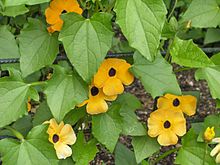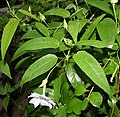Thunbergia
| Thunbergia | |
|---|---|

| |
| Flowers of Thunbergia alata | |
| Scientific classification | |
| Kingdom: | Plantae |
| Clade: | Tracheophytes |
| Clade: | Angiosperms |
| Clade: | Eudicots |
| Clade: | Asterids |
| Order: | Lamiales |
| Family: | Acanthaceae |
| Subfamily: | Thunbergioideae |
| Genus: | Thunbergia Retz. (1780)[1] |
| Species[2] | |
|
150; see text | |
| Synonyms[2] | |
| |
Thunbergia is a genus of flowering plants in the family Acanthaceae. It includes 150 species native to tropical and subtropical regions of sub-Saharan Africa, Madagascar, southern Asia, New Guinea, and Australia.[2] Thunbergia species are vigorous annual or perennial vines and shrubs growing to 2–8 m tall. The generic name honours the Swedish naturalist Carl Peter Thunberg (1743-1828).
Its members are known by various names, including thunbergias and clockvine. Thunbergia on its own usually refers to Thunbergia grandiflora, while Thunbergia alata is often known as black-eyed Susan vine or just black-eyed Susan (not to be confused with other flowers called black-eyed Susan). Orange clockvine is the name of Thunbergia gregorii.
Thunbergias are frequent garden escapes, becoming invasive species; T. grandiflora, T. fragrans, and T. laurifolia are considered weeds in Australia.[3]
Selected species
[edit]150 species are accepted.[2] Selected species include:
- Thunbergia alata Bojer ex Sims
- Thunbergia annua Hochst. ex Nees
- Thunbergia atriplicifolia E.Mey. ex Nees[4]
- Thunbergia battiscombei Turrill
- Thunbergia coccinea Wall. ex D.Don
- Thunbergia cordata Colla
- Thunbergia elegans Borzì
- Thunbergia erecta (Benth.) T. Anderson
- Thunbergia fragrans Roxb.
- Thunbergia gibsonii S. Moore
- Thunbergia grandiflora Roxb.
- Thunbergia gregorii S.Moore
- Thunbergia ikbaliana De Wild.
- Thunbergia laurifolia Lindl.
- Thunbergia lutea T. Anderson
- Thunbergia mysorensis (Wight) T.Anderson
- Thunbergia natalensis Hook.
- Thunbergia vogeliana Benth.
- Thunbergia wightiana T.Anderson[5]
Formerly placed here
[edit]- Meyenia hawtayneana (Wall.) Nees (as T. hawtayneana Wall.)[5]
Gallery
[edit]References
[edit]- ^ "Genus: Thunbergia Retz". Germplasm Resources Information Network. United States Department of Agriculture. 2007-10-05. Archived from the original on 2012-10-09. Retrieved 2010-10-30.
- ^ a b c d Thunbergia Retz. Plants of the World Online. Retrieved 7 February 2024.
- ^ Weeds Australia, National Weeds Strategy, retrieved 27 March 2015
- ^ "Red List of South African Plants". SANBI. Retrieved 7 January 2019.
- ^ a b "GRIN Species Records of Thunbergia". Germplasm Resources Information Network. United States Department of Agriculture. Archived from the original on 2015-09-24. Retrieved 2010-10-30.
External links
[edit]- A Tale of Two Susans II - non-scholarly essay on the etymology and history of Thunbergia (and Carl Peter Thunberg)






